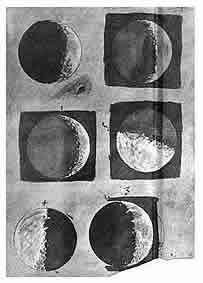Telescope: Difference between revisions
imported>Thomas Simmons No edit summary |
imported>Thomas Simmons |
||
| Line 17: | Line 17: | ||
===[[Galileo Galilei]]=== | ===[[Galileo Galilei]]=== | ||
Galileo first heard of the telescope in 1609 and was able construct his own model from the description given him about the device patented by a spectacle maker in the Netherlands, Hans Lipperhey. He made several models including an 8-power telescope and a 20-power.<ref> Drake, Stillman (1973). "Galileo's Discovery of the Law of Free Fall". Scientific American v. 228, #5: 84-92 </ref> Galileo went on to make observations of the Moon, the Sun, the planets and stars <ref> Galilei, Galileo (1610). The Starry Messenger (Sidereus Nuncius). In Drake (1957):22-58 </ref> | [[Image:49812main telescope feature1 912.jpg|right|thumb|350px|{{#ifexist:Template:49812main telescope feature1 912.jpg/credit|{{49812main telescope feature1 912.jpg/credit}}<br/>|}}Galileo's ink renderings of the moon: the first telescopic observations of a celestial object.]] Galileo first heard of the telescope in 1609 and was able construct his own model from the description given him about the device patented by a spectacle maker in the Netherlands, Hans Lipperhey. He made several models including an 8-power telescope and a 20-power.<ref> Drake, Stillman (1973). "Galileo's Discovery of the Law of Free Fall". Scientific American v. 228, #5: 84-92 </ref> Galileo went on to make observations of the Moon, the Sun, the planets and stars <ref> Galilei, Galileo (1610). The Starry Messenger (Sidereus Nuncius). In Drake (1957):22-58 </ref> | ||
==Types of telescopes== | ==Types of telescopes== | ||
Revision as of 19:56, 22 March 2008
The word "telescope" comes from two Greek words: tele (τηλε)[1] meaning “far” or “distant”, and skopein (σκοπειν) meaning “to see.” Together they simply mean “to see from far away.[2]
A simple description of telescope is an instrument designed to magnify distant objects so that they can be viewed more easily. Telescopes historically have been constructed of lenses and mirrors which concentrate visible light into a smaller and more defined image.
History of the development of the telescope
Leonard Digges (1520-1559)
Leonard Digges was a writer of mathematics and science in English, one of the first people to popularise work in either field. He was also a surveyor who invented the theodolite, the telescope, the reflecting telescope and possibly the refractive telescope. He published a number of works during his lifetime but his achievements were expanded and revised by his son Thomas and published after Leonard's death, some of the work for the first time.[3][4][5][6]
Thomas Digges (1543-1595)
In 1571, Thomas Digges published Leonard Digges's book on the telescope, Pantometria, twelve years after his father's death. Panometria was the first publications to discuss the invention of the telescope in English. Thomas had extended, revised and enhanced the book and he wrote the preface.
Thomas’s publication, Alae seu scalae mathematicae, in 1573, was a Latin text prompted by the new star of 1572, a supernova.[7] Thomas's observations were employed by Tycho Brahe in his work. The supernova created quite a stir worldwide and certainly in Europe. There was a tremendous increase in astronomical and astrological work and publications. Tycho Brahe's supernova was significant because it encouraged astronomers in the 16th-century to question their perception that the heavans were immutable, that is, unchanging. Thomas's contribution was to determined the nova's position and his conclusion that its appearance was a challenge to traditional cosmology of the day. [3][4][8][9][10]
Galileo Galilei
Galileo first heard of the telescope in 1609 and was able construct his own model from the description given him about the device patented by a spectacle maker in the Netherlands, Hans Lipperhey. He made several models including an 8-power telescope and a 20-power.[11] Galileo went on to make observations of the Moon, the Sun, the planets and stars [12]
Types of telescopes
References
- ↑ for example, télothen (τηλóθν), “from a distance” télourós (τηλουρóς), “far off.”
- ↑ [1], [2] & [3] S.C. Woodhouse (1910) Woodhouse's English-Greek Dictionary, The University of Chicago Library
- ↑ 3.0 3.1 Gribbin, J. (2002) Science: A history. London: Penguin
- ↑ 4.0 4.1 Thomas Digges: Gentleman and mathematician Stephen Johnston (1994) chapter 2 (pp. 50-106) of, ‘Making mathematical practice: gentlemen, practitioners and artisans in Elizabethan England’ Ph.D. thesis, Cambridge. Available through University of Oxford, Museum of History of Science
- ↑ Thomas Digges O'Connor, J. J. and Robertson, E. F. (2002) MacTutor History of Mathematics Archive, School of Math and Statistics, University of St. Andrews.
- ↑ Leonard Digges Richard S. Westfall, Department of History and Philosophy of Science, Indiana University for the Galileo Project, Rice University
- ↑ sometimes referred to as Tycho's Supernova See reference to NASA/ESA Space Telescope cited below.
- ↑ Thomas Digges O'Connor, J. J. and Robertson, E. F. (2002) MacTutor History of Mathematics Archive, School of Math and Statistics, University of St. Andrews.
- ↑ Thomas Digges Richard S. Westfall, Department of History and Philosophy of Science, Indiana University for the Galileo Project, Rice University
- ↑ heic0415: Stellar survivor from 1572 A.D. NASA/ESA Space Telescope. On Nov. 11, 1572, Tycho Brahe observed a star in the constellation Cassiopeia as bright as Jupiter which eventually equaled Venus in brightness. It was visible during daylight for about two weeks and eventually faded from unaided view altogether after about 16 months.
- ↑ Drake, Stillman (1973). "Galileo's Discovery of the Law of Free Fall". Scientific American v. 228, #5: 84-92
- ↑ Galilei, Galileo (1610). The Starry Messenger (Sidereus Nuncius). In Drake (1957):22-58
